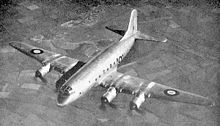Handley Page Hastings
Development of the Hastings had been initiated during the Second World War in response to Air Staff Specification C.3/44, which sought a new large four-engined transport aircraft for the RAF.
The type was rushed into service so that it could participate in the Berlin Airlift; reportedly, the fleet of 32 Hastings to be deployed during the RAF operation delivered a combined total of 55,000 tons (49,900 tonnes) of supplies to the city.
[1] According to aviation periodical Flight International, the H.P.67 was an extremely aerodynamically clean design, as well as being relatively orthodox in terms of Handley Page methodology.
These weather reconnaissance aircraft were stripped of their standard interiors, the space being instead occupied by meteorological measuring and recording equipment, along with a galley and wardroom to improve crew comfort during routine flights of up to nine hours.
[6] While tail modifications introduced to the C1 had allowed the type to enter service, a more definitive solution was provided in the form of an extended-span tailplane, which was mounted lower on the fuselage.
[2] It was furnished with several modern features, such as a Messier-built fully retractable undercarriage, which was operated hydraulically, and unprecedented stowage space for an RAF transport aircraft.
[9] The cabin was fitted with a Plymax floor, complete with various grooves, channels, and lashing points for securing goods of varying sizes, while the walls were sound proofed and lined with plywood for increased comfort.
[9] In service, the aircraft was typically operated by a crew of five; it could accommodate either up to 30 paratroopers, 32 stretchers and 28 sitting casualties, or a maximum of 50 fully equipped troops.
[citation needed] In terms of its structure, the Hastings features a circular cross-section fuselage, which is constructed in three main sections from frames comprising rolled alloy.
[10] The frames are typically Z-section units using intercostal plate members, but the wing box makes use of larger I-section structures; these support a metal sheet covering that is rivetted directly onto stringer flanges.
[9] In order that the Hastings could carry loads too large for its interior, such as Jeeps and some artillery pieces, strong fixture points are present on the underside of the fuselage for the fitting of an under-fuselage carrier platform.
[9] The Hastings had been rushed into service with the RAF during September 1948 due to the pressing need for additional transport aircraft to meet the demands of the Berlin Airlift.
During the airlift, the Hastings fleet was intensively used, principally to carry shipments of coal to the city; before the end of the crisis, two further squadrons, 297 and 53, would be involved in the effort.
[18] The Hastings T.Mk 5 remained in service as radar trainers well into the 1970s; the variant was used for other purposes as well during this time, such as the occasional transport, air experience, and search and rescue missions.
During the period that the engines were having problems with their sleeve valves (lubricating oil difficulties) RNZAF personnel joked that the Hastings was the best three-engined aircraft in the world.










